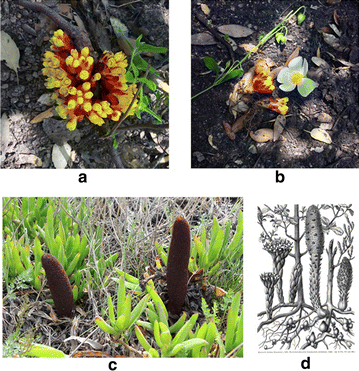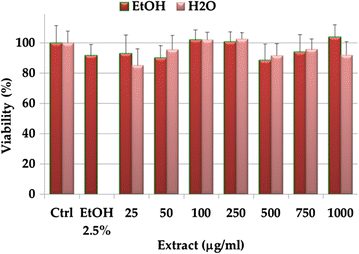Antimicrobial, antioxidant and anti-tyrosinase properties of extracts of the Mediterranean parasitic plant Cytinus hypocistis
- PMID: 26462912
- PMCID: PMC4603636
- DOI: 10.1186/s13104-015-1546-5
Antimicrobial, antioxidant and anti-tyrosinase properties of extracts of the Mediterranean parasitic plant Cytinus hypocistis
Abstract
Background: Cytinus is an endophytic parasitic plant occurring in South Africa, Madagascar, and in the Mediterranean region. We have extracted the inflorescences (the only visible part of the plant, emerging from the host roots at the time of blossom) of Cytinus hypocistis collected in Sardinia, Italy, and explored the antimicrobial, antioxidant, anti-tyrosinase, and cytotoxic activities of the extracts.
Methods: Extracts from C. hypocistis were prepared using increasing polarity solvents: cyclohexane, ethanol, and water. Phenolic composition were determined through spectrophotometric assays, and antioxidant activity with both electron-transfer and hydrogen-atom assays. Nine different bacterial strains, including clinical isolate methicillin-resistant Staphylococcus aureus, were used in agar diffusion method. Cytotoxicity was tested using against the B16F10 melanoma cell line.
Results: While cyclohexane extracts where biologically inactive, ethanolic and aqueous extracts displayed an intriguing activity against several Gram-positive bacterial strains, including methicillin-resistant S. aureus, and against the Gram-negative Acinetobacter baumanii. Compared to the conventional antibiotics like cloxacillin, ampicillin, and oxytetracycline, C. hypocistis extracts were less active in absolute terms, but displayed a wider spectrum (notably, cloxacillin and ampicillin were inactive against methicillin-resistant S. aureus). The ethanolic extract of C. hypocistis was found to be particularly rich in polyphenols, in most part hydrolysable tannins. The antioxidant activity of extracts, tested with several methodologies, resulted to be particularly high in the case of ethanolic extracts, in accordance with the composition in phenolics. In detail, ethanol extracts presented about a twofold higher activity than the water sample when tested through the oxygen radical absorbance capacity-pyrogallol red (ORAC-PYR) assay. Cytotoxicity analysis against the B16F10 melanoma cell line showed that both extracts have not significant cytotoxic effect, even at the highest dose (1000 µg/mL). Tests showed that ethanolic extracts also had the greatest tyrosinase inhibition activity, indicating that C. hypocistis-derived substances could find application in food formulations as anti-browning agents.
Conclusions: Overall, these results point to the need of further studies on C. hypocistis extracts, aimed at isolating and fully characterizing its biologically active compounds.
Figures


Similar articles
-
Tannin profile, antioxidant properties, and antimicrobial activity of extracts from two Mediterranean species of parasitic plant Cytinus.BMC Complement Altern Med. 2019 Apr 5;19(1):82. doi: 10.1186/s12906-019-2487-7. BMC Complement Altern Med. 2019. PMID: 30952208 Free PMC article.
-
Exploring the phytochemical profile of Cytinus hypocistis (L.) L. as a source of health-promoting biomolecules behind its in vitro bioactive and enzyme inhibitory properties.Food Chem Toxicol. 2020 Feb;136:111071. doi: 10.1016/j.fct.2019.111071. Epub 2019 Dec 21. Food Chem Toxicol. 2020. PMID: 31870918
-
Antimicrobial Activities of Methanol, Ethanol and Supercritical CO2 Extracts of Philippine Piper betle L. on Clinical Isolates of Gram Positive and Gram Negative Bacteria with Transferable Multiple Drug Resistance.PLoS One. 2016 Jan 7;11(1):e0146349. doi: 10.1371/journal.pone.0146349. eCollection 2016. PLoS One. 2016. PMID: 26741962 Free PMC article.
-
Antimicrobial Capacity of Plant Polyphenols against Gram-positive Bacteria: A Comprehensive Review.Curr Med Chem. 2020;27(15):2576-2606. doi: 10.2174/0929867325666181008115650. Curr Med Chem. 2020. PMID: 30295182 Review.
-
Polyphenols as antimicrobial agents.Curr Opin Biotechnol. 2012 Apr;23(2):174-81. doi: 10.1016/j.copbio.2011.08.007. Epub 2011 Sep 16. Curr Opin Biotechnol. 2012. PMID: 21925860 Review.
Cited by
-
Selectivity Tuning by Natural Deep Eutectic Solvents (NADESs) for Extraction of Bioactive Compounds from Cytinus hypocistis-Studies of Antioxidative, Enzyme-Inhibitive Properties and LC-MS Profiles.Molecules. 2022 Sep 7;27(18):5788. doi: 10.3390/molecules27185788. Molecules. 2022. PMID: 36144535 Free PMC article.
-
Antimicrobial Nanomaterials Derived from Natural Products-A Review.Materials (Basel). 2016 Mar 30;9(4):255. doi: 10.3390/ma9040255. Materials (Basel). 2016. PMID: 28773379 Free PMC article. Review.
-
Use of Essential Oils to Counteract the Phenomena of Antimicrobial Resistance in Livestock Species.Antibiotics (Basel). 2024 Feb 7;13(2):163. doi: 10.3390/antibiotics13020163. Antibiotics (Basel). 2024. PMID: 38391549 Free PMC article. Review.
-
Cytinus under the Microscope: Disclosing the Secrets of a Parasitic Plant.Plants (Basel). 2021 Jan 12;10(1):146. doi: 10.3390/plants10010146. Plants (Basel). 2021. PMID: 33445677 Free PMC article. Review.
-
Tannin profile, antioxidant properties, and antimicrobial activity of extracts from two Mediterranean species of parasitic plant Cytinus.BMC Complement Altern Med. 2019 Apr 5;19(1):82. doi: 10.1186/s12906-019-2487-7. BMC Complement Altern Med. 2019. PMID: 30952208 Free PMC article.
References
-
- Pardo-de-Santayana M, Pieroni A, Puri RK. Ethnobotany in the New Europe: people, health and wild plant resources. New York: Berghahn Books; 2010.
Publication types
MeSH terms
Substances
LinkOut - more resources
Full Text Sources
Other Literature Sources
Medical
Molecular Biology Databases

